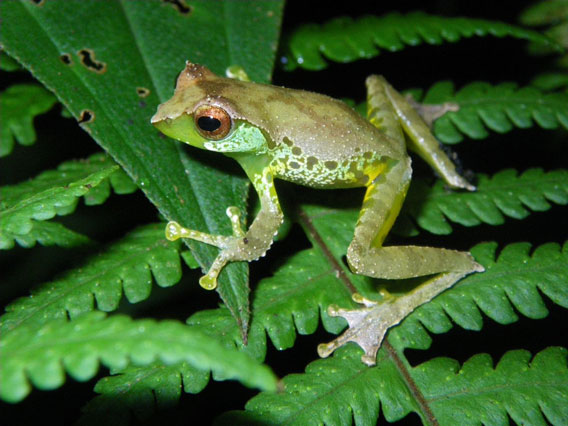
The male Quang’s tree frog has uniquely complex vocalizations. Photo by: Jodi J. L. Rowley/Australian Museum.
If you’re trudging through the high-altitude forests of northern Vietnam and you hear bird song, you might want to check the trees for frogs. Yes, that’s right: frogs. A new species of tree frog has been discovered in Vietnam that researchers say has a uniquely complex call that makes it sound more like a bird than a typical frog. Discovered in Pu Hoat Proposed Nature Reserve, the new species, dubbed Quang’s tree frog (Gracixalus quangi), dwells in the forests at an altitude 600-1,300 meters (nearly 2,000-4,265 feet).
“Quang’s tree frog […] has a hyperextended vocal repertoire—in other words, it doesn’t just repeat the same call over and over, but has a number of types of calls. In fact, no two calls that I recorded were exactly the same, with each frog mixing clicks, whistles and chirps in no apparent order! It is the most variable frog call that I’ve heard of, and sounds a lot more like a bird song than a frog call [click here to listen to the frog’s call],” lead author Jodi Rowley with the Australian Museum in Sydney told mongabay.com.
Unlike Quang’s tree frog, Rowley says the majority of frog species stick to one note to attract females.
“[Most male frogs] call to attract females with a rather repetitive call (eg. the familiar “croak, croak, croak” or “chirp, chirp, chirp”, for example). While each species has a different call (it helps prevent females attracting frogs of the wrong species!), most frog advertisement calls are of roughly one type of call, repeated until they get the girl.”
Quang’s tree frog belongs to the Rhacophoridae family, which currently contains over 300 species. A few of these have also evolved a more elaborate communication range, though none as complex as Quang’s. Researchers are unsure why the frogs make so many sounds.
“While it’s all just speculation at this stage, it may be that some parts of the call (eg. clicks) communicate to other males (eg. ‘back off!’), and others (eg. whistles) are especially attractive to females,” Rowley explains. “It makes sense that the species is territorial, as they lay their eggs on the tips of leaves overhanging shallow water, and there’s only a certain number of good leaves around.”
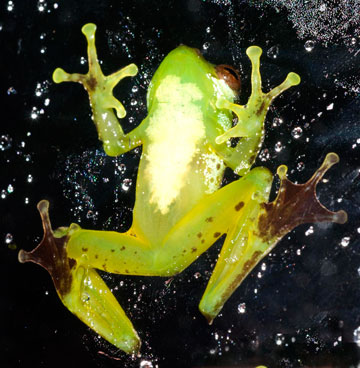 A male Quang’s tree frog viewed from the bottom. Photo by: Jodi J. L. Rowley/Australian Museum. |
Rowley says they are uncertain at this point whether or not the new species is threatened.
“This is the case for a large number of Southeast Asian frogs, which remain listed as ‘Data Deficient’ under the IUCN Red List categories (rather than Least Concern, Endangered, etc). The new species was discovered in a remote, protected area, so we believe that the species is safe at the moment, at least in that area. We believe it does occur in a larger area, though, but only further surveys will reveal just how widely distributed it is.”
Rowley has been involved in discovering ten new amphibians in Southeast Asia over the last few years, but says she can’t pick a favorite. She adds, however, that “for some reason I am quite fond of the tiny brown frogs that live leaf-litter and sound like crickets (frogs in the genus Leptolalax).”
Globally, the world’s amphibians are facing an extinction crisis. It’s believed that at least 120 amphibians have gone extinct in the last 30 years, while 41 percent of the world’s 7,000 known amphibians are considered threatened with extinction by the IUCN Red List. Deforestation, wetland loss, pollution, overexploitation, the pet trade, invasive species, and climate change have all taken a toll on these sensitive creatures, which have been dubbed by many ecologists as “canaries in a coal mine” for their ability to point out environmental degradation. In addition, a deadly fungal disease called chytridiomycosis has wiped out whole species even in pristine environments.
Bordering Laos, Pu Hoat Proposed Nature Reserve was at one time home to Indochinese tigers (Panthera tigris corbetti), Asian elephants (Elephas maximus) and the only-recently discovered saola (Pseudoryx nghetinhensis). However all three of these species are now believed to be extinct from the area. Still the forest is home to the wild cattle, gaur (Bos gaurus), which is listed as Vulnerable by the IUCN Red List; the Assam macaque (Macaca assamensis) listed as Near Threatened; and one of Vietnam’s only populations of the conifer, Cunninghamia konishii, which is listed as Vulnerable. It is also home to disputed species of muntjac—a type of small Asian deer. A survey of lower elevation birds in the 1990s found 142 species. Although the forest is currently protected, it has not yet gained full Nature Reserve status.
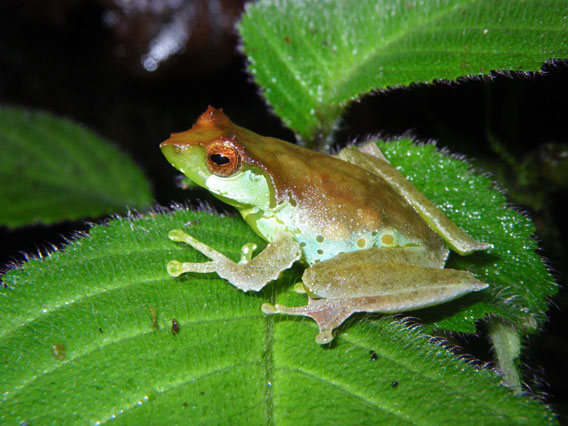
Female Quang’s tree frog. Photo by: Jodi J. L. Rowley/Australian Museum.
CITATION: Rowley, J. J. L., Dau Q. V., Nguyen T. T., Cao T. T., & Nguyen, S. V. (2011). A new species of Gracixalus (Anura: Rhacophoridae) with a hyperextended vocal repertoire from Vietnam. Zootaxa 3125: 22-38.
Related articles
Photos: two new paper clip-sized frogs discovered in Vietnamese mountains
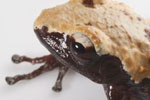
(12/07/2011) Researchers have discovered two new frog species living in the montane tropical forests of Vietnam. Known as moss frogs, these small amphibians employ camouflage as one way to keep predators at bay, in some cases resembling the moss that gives them their name.
Effort to save world’s rarest frogs recognized with conservation award
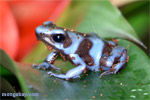
(12/05/2011) An effort to save the world’s most endangered amphibians has won mongabay.com’s 2011 conservation award. Amphibian Ark — a joint effort of the World Association of Zoos and Aquariums, the IUCN/SSC Conservation Breeding Specialist Group, and the IUCN/SSC Amphibian Specialist Group — is working to evaluate the status of threatened amphibians, raise awareness about the global amphibian extinction crisis, and set up captive breeding programs. The initiative is targeting 500 species that will not survive without captive breeding efforts.
Smelly frogs may be key to fighting antibiotic-resistant infections
(12/01/2011) Foul smelling frogs may save lives, according to new research in the Journal of Proteome Research. Examining nine species of Chinese frogs, known as “odorous” frogs for their off-putting smell, researchers have discovered an astounding variety of antimicrobial peptides, or put simply bacteria-killers.